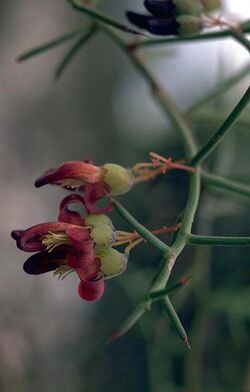Biology:Daviesia glossosema
| Maroon-flowered daviesia | |
|---|---|

| |
| Daviesia glossosema in the Stirling Range | |
| Scientific classification | |
| Kingdom: | Plantae |
| Clade: | Tracheophytes |
| Clade: | Angiosperms |
| Clade: | Eudicots |
| Clade: | Rosids |
| Order: | Fabales |
| Family: | Fabaceae |
| Subfamily: | Faboideae |
| Genus: | Daviesia |
| Species: | D. glossosema
|
| Binomial name | |
| Daviesia glossosema Crisp[1]
| |
Daviesia glossosema, commonly known as maroon-flowered daviesia,[2] is a species of flowering plant in the family Fabaceae and is endemic to a restricted area of south-western Western Australia. It is an erect shrub with tangled, spreading branches, cylindrical, sharply-pointed phyllodes, and unusually-shaped maroon flowers.
Description
Daviesia glossosema is an erect shrub that typically grows to a height of 0.5–1 m (1 ft 8 in–3 ft 3 in) and has spreading, tangled branches with glaucous foliage. Its leaves are reduced to scattered, erect, needle-shaped, sharply-pointed phyllodes 8–40 mm (0.31–1.57 in) long and about 1 mm (0.039 in) wide. The flowers are arranged in racemes of two to five on a peduncle 4–7 mm (0.16–0.28 in) long, the rachis 1–3 mm (0.039–0.118 in) long, each flower on a pedicel 3–5 mm (0.12–0.20 in) long with bracts about 1 mm (0.039 in) long at the base. The sepals are about 4 mm (0.16 in) long and joined at the base with minute teeth. The petals are maroon, the standard egg-shaped, 10.0–10.5 mm (0.39–0.41 in) long and curved backwards, the wings about 11.5–13.5 mm (0.45–0.53 in) long and curved inwards exposing the keel and stamens, and the keel is about 8 mm (0.31 in) long. Flowering occurs from September to November and the fruit is an inflated triangular pod 14–20 mm (0.55–0.79 in) long.[2][3][4][5]
Taxonomy and naming
Daviesia glossosema was first formally described in 1995 by Michael Crisp in Australian Systematic Botany.[6] The specific epithet (glossosema) is derived from words meaning "tongue" and "standard", referring to the unusual shape of that petal.[2]
Distribution and habitat
Maroon-flowered daviesia grows in heath in a small area of the Stirling Range in the south-west of Western Australia.[2][3][4]
Conservation status
Daviesia glossosema is listed as "Threatened Flora (Declared Rare Flora — Extant)" by the Department of Biodiversity, Conservation and Attractions and an Interim Recovery Plan has been prepared.[2][3]
References
- ↑ "Daviesia glossosema". Australian Plant Census. https://biodiversity.org.au/nsl/services/apc-format/display/154777.
- ↑ 2.0 2.1 2.2 2.3 2.4 Phillimore, Robyn; Brown, Andrew. "Maroon-flowered daviesia (Daviesia glossosema) interim recovery plan 2001–2004". Government of Western Australia Department of Conservation and Land Management. https://www.dpaw.wa.gov.au/images/documents/plants-animals/threatened-species/recovery_plans/Approved_interim_recovery_plans_/dav_glo_irp94.pdf.
- ↑ 3.0 3.1 3.2 "Daviesia glossosema". FloraBase. Western Australian Government Department of Parks and Wildlife. https://florabase.dpaw.wa.gov.au/browse/profile/15067.
- ↑ 4.0 4.1 Crisp, Michael D.; Cayzer, Lindy; Chandler, Gregory T.; Cook, Lyn G. (2017). "A monograph of Daviesia (Mirbelieae, Faboideae, Fabaceae)". Phytotaxa 300 (1): 153–154. doi:10.11646/phytotaxa.300.1.1.
- ↑ Crisp, Michael D. (1980). "Daviesia and Leptosema (Fabaceae) in central Australia: new species and name changes". Journal of the Adelaide Botanic Gardens 2 (3): 249–250. https://data.environment.sa.gov.au/Content/Publications/JABG02P271_Crisp.pdf. Retrieved 14 January 2022.
- ↑ "Daviesia glossosema". APNI. https://id.biodiversity.org.au/instance/apni/556959.
Wikidata ☰ Q27828434 entry
 |

